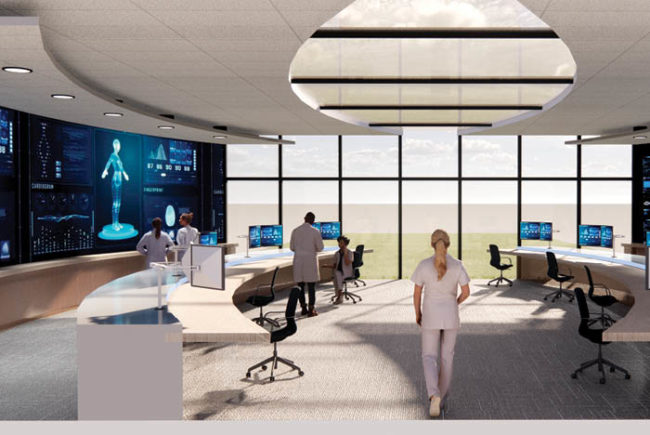You've retro-commissioned your existing facilities to make them as energy efficient as possible, upgrading equipment as needed and implementing light-emitting diode (LED) technology and daylight harvesting to reduce electricity consumption.
But you know that your health facilities could still significantly reduce their energy use intensity (EUI). That means it's time to consider alternative energy sources, says Kevin Prince, director of business development at NRG Renew, part of NRG Energy, headquartered in Princeton, N.J.
A huge commitment
Oakland, California-based Kaiser Permanente, which includes 38 hospitals and 600 medical office buildings and other facilities, is one health care organization that has made a huge commitment to renewable energy. Originally planning to reduce its greenhouse gas emissions by 30 percent between 2008 and 2020, Kaiser now expects to reach that goal by 2017 as a result of two recent agreements.
Kaiser has signed a 20-year contract to purchase up to 70 megawatts (MWe) of onsite solar production from NRG Renew, with construction of the photovoltaic installations beginning this year. NRG Renew will build, own and operate the rooftop- and ground-mounted solar equipment, which will be added to as many as 170 of Kaiser's hospitals and other facilities in California. Under a separate 20-year agreement, the health care organization also will purchase a substantial amount of offsite solar- and wind-generated electricity from another clean energy company.
These renewable energy contracts and other energy-saving measures will reduce Kaiser's share of greenhouse gas emissions from 806,000 to 617,000 metric tons a year, Ramé Hemstreet, Kaiser's chief energy officer, estimates.
"Kaiser historically has had aggressive sustainability goals, so they've always been at the forefront among health care providers in reducing greenhouse gases," notes Ken Cowan, NRG's senior account executive for business solutions.
The other key driver in Kaiser's decision making is return on investment. "With the solar project we have with Kaiser, the organization is expected to save up to $4 million in the first year alone," Cowan says. "The way the agreement is structured, Kaiser is not spending any capital up front. The return is quick, because the health system will be paying us over a 20-year, power-purchase agreement."
More than 95 percent of the solar arrays will be installed on Kaiser's existing hospitals and medical office buildings. In addition, solar equipment will be added to carports that are being constructed on a number of campus parking lots. "Many Kaiser employees and patients will have the added comfort of covered parking," says Cowan, who notes that another NRG entity, NRG eVgo, is installing and operating electric-vehicle charging stations on Kaiser campuses.
The proportion of electricity generated by the solar installations will vary by facility, but will average around 60 percent of total consumption, Prince estimates. All of the buildings still will be connected to the grid. "The benefit there is that if the solar installation overproduces what the facility needs, it will feed electricity back to the grid and Kaiser will get a credit on its electric bill," Prince says.
Solar energy makes economic sense in California because energy costs are high, sunshine is abundant, the state prioritizes environmental sustainability and incentives are available to enterprises that purchase or produce clean energy.
“It's important to act quickly, though; to take full advantage of the federal tax credit for investing in renewable energy,” Prince says. After December 31, 2016, a 30 percent tax credit on solar energy equipment will decrease to 10 percent. In addition, substantial tax credits for geothermal heat pumps, small wind-energy systems, fuel cells and combined heat and power (CHP) systems will expire.
Paradigm shift
Gundersen Health System in La Crosse, Wisconsin, also stands at the vanguard of renewable energy generation. In 2008, the health system vowed to become energy independent by the end of 2014.
"We reached that goal on October 14, 2014," says Jeff Rich, the executive director of Envision, Gundersen's environmental sustainability program. "That was the first day we made more energy than we consumed from fossil fuel sources."
In partnership with Organic Valley, a large cooperative of organic farmers, Gundersen built a two-turbine wind farm near Cashton, Wisconsin, that produces nearly 5 MWe. The health system has a second wind farm of the same size and output just north of Lewiston, Minnesota, about 40 miles west of La Crosse. Accounting for approximately 12 percent of Gundersen's energy output, the two wind sites provide electricity to the grid, for which Gundersen gets paid.
"If you're putting the power that you generate onto the grid, you're doing the same thing as if you were feeding it to yourself," Rich says. "It's a paradigm shift that health systems have to consider."
Gundersen also spearheaded a landfill-gas CHP project in cooperation with La Crosse County. A landfill in Onalaska, Wisconsin, supplies methane gas to a Gundersen campus 1.5 miles away. "We have an internal combustion engine on our campus, similar to a car engine but much larger, that converts the methane into electricity," says Rich.
Gundersen produces more electricity than it can consume on the Onalaska campus, so it sells the excess electricity to a local electric utility. In addition, the campus is able to capture the waste heat generated by the engine — enough to heat a large office building and clinic.
But Gundersen's largest alternative energy project is a biomass boiler at Gundersen Lutheran Medical Center, which provides 80 percent of the heating on its hospital campus and offsets 38 percent of the electricity demand for the health system. "We have a steam turbine behind the boiler that produces electricity, which reduces what we need to purchase from the grid because we're serving our own load," Rich explains.
The biomass boiler uses organic wood fuel, such as milling and forest residues, to heat water and create steam used throughout the La Crosse campus. Funded in part by a Wisconsin bioenergy grant, the boiler is expected to save Gundersen approximately $500,000 a year.
Other alternative-energy initiatives at Gundersen include a geothermal heat pump system on the main campus and two dairy manure digesters on local farms, one served by 1,000 cows and the other by 2,000.
"You need to think about what your state's waste products are," says Rich. "In Wisconsin, we have a lot of dairy cows, so manure becomes a resource we can use as feedstock to make clean energy."
Clean energy, improved health
Producing clean energy fits with the missions of Gundersen Health, Kaiser Permanente and other environmentally conscious health systems.
"Our mission is to enhance health and well-being in the communities we serve," says Rich
The best alternative energy choices for a health system depend on the “three Rs,” says NRG's Prince: resources, rates and rebates. How sunny or windy is your area? How much are you paying for conventional electricity? What incentives are available?
NRG works with clients across the country to develop the best energy solutions for particular enterprises and locales.
"We look at clients’ locations and analyze and review the data with them," Cowan explains. "What do their loads look like? How much power are they taking? What incentives are offered in their state for various technologies? What are their sustainability goals? When you put all of the pieces together and collaborate with the client, you find a 'sweet spot.'"
This is the third in a series of articles on energy management.




